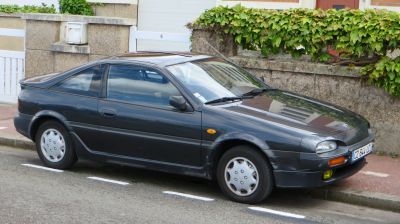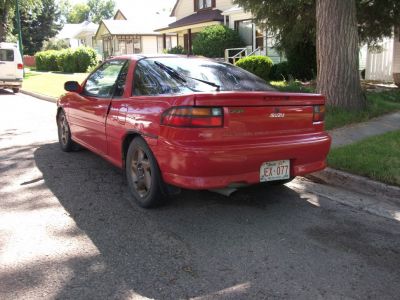 1990 Geo Storm Dimensions, Size & Specs
1990 Geo Storm Dimensions, Size & SpecsMeasurements of the 1990 Geo Storm, engineered for optimal performance and comfort
| Dimensions | |
|---|---|
| Length: | 4150 mm163.4 in13.6 ft |
| Width: | 1695 mm66.7 in5.6 ft |
| Height: | 1300 mm51.2 in4.3 ft |
| Trunk Capacity: | 310 liter10.9 cu ft |
| Trunk Capacity (Max): | 620 liter21.9 cu ft |
| Weight Specifications | |
| Curb Weight: | 1010-1035 kg2227-2282 lbs |
| Tire Specifications | |
| Rims Sizes: |
|
| Tire Sizes: |
|
The 1990 Geo Storm coupe, produced from 1990 to 1993, is a compact sport-oriented vehicle that offers a balanced blend of style, practicality, and manageable dimensions. With an overall length of 4150 mm (163.4 inches), a width of 1695 mm (66.7 inches), and a low height of 1300 mm (51.2 inches), the Geo Storm presents a sleek and aerodynamic profile typical of early 1990s sporty coupes. Its curb weight ranges from 1010 to 1035 kilograms (2227 to 2283 pounds), making the vehicle both lightweight and nimble, contributing to its responsive handling and fuel efficiency.
Inside, the Geo Storm provides a reasonable amount of luggage space for a compact coupe, offering 310 liters (10.9 cubic feet) of cargo capacity with the rear seats in their standard position. Folding down the rear seats nearly doubles the available storage to 620 liters (21.9 cubic feet), accommodating larger items and enhancing practicality for daily use or weekend trips.
The car rides on rim sizes of 14 or 15 inches, paired with tire dimensions of either 185/60 R14 or 205/50 R15, balancing sporty aesthetics with road grip and comfort. These specifications make the Geo Storm a competitive choice in its segment during its production years, appealing to drivers seeking a compact yet dynamic coupe with sufficient storage options and distinctive styling. Overall, the 1990 Geo Storm remains a notable example of compact coupe design from the early '90s, combining efficient dimensions with a sporty character.
Discover the standout features that make the 1990 Geo Storm a leader in its class
Have a question? Please check our knowledgebase first.
The 1990 Geo Storm coupe has a length of 4150 mm (163.4 inches), a width of 1695 mm (66.7 inches), and a height of 1300 mm (51.2 inches). These compact dimensions reflect its sporty coupe design, making it nimble and well-suited for urban environments while maintaining a sleek and low profile.
The curb weight of the 1990 Geo Storm ranges between 1010 kg to 1035 kg (approximately 2227 to 2282 pounds). This relatively light weight contributes to its agile handling and improved fuel efficiency, characteristic of a compact sport coupe from the early 1990s.
The Geo Storm has a standard luggage capacity of 310 liters (about 10.9 cubic feet). When the rear seats are folded down, the luggage capacity expands to 620 liters (around 21.9 cubic feet), effectively doubling the cargo space. This flexibility enhances practicality for carrying larger items despite the compact size of the coupe.
The Geo Storm originally came equipped with rim sizes of 14 or 15 inches. Corresponding tire sizes include 185/60 R14 and 205/50 R15. These dimensions support a sporty yet balanced ride quality, with the 15-inch option offering a sportier appearance and potentially sharper handling characteristics.
Yes, the 1990 Geo Storm fits comfortably into a standard residential garage. Given its length of 4150 mm (163.4 inches) and width of 1695 mm (66.7 inches), it is smaller than most typical garage spaces, which generally measure around 2440 mm to 3050 mm (8 to 10 feet) in width and over 5000 mm (16 feet) in length. Its low height of 1300 mm (51.2 inches) also poses no issue with overhead clearance inside garages.
The Geo Storm was essentially a rebadged and modified version of the Suzuki Swift/Swift GTi, as it did not have a direct predecessor under the Geo brand. Compared to the Suzuki Swift from which it was derived, the Storm retained similar compact dimensions and lightweight build. This continuity maintained its sporty coupe appeal while offering slight design and feature differences tailored for the North American market.
When compared to similar compact sport coupes from the early 1990s, such as the Honda CR-X or the Toyota MR2, the Geo Storm is comparable in length and width but typically lighter and lower in height. The Honda CR-X measures around 3995 mm (157.3 inches) in length, shorter than the Storm, while the MR2 is slightly longer but similar in width. The Geo Storm's balance of compact dimensions and low curb weight makes it competitive in its segment.
With a curb weight between 1010 kg and 1035 kg (2227 to 2282 lbs), the Geo Storm benefits from a relatively light body, which positively influences acceleration, handling agility, and fuel consumption. Light weight reduces the load on the engine and suspension, allowing for a nimble driving experience and better fuel economy compared to heavier vehicles in the same class.
The Geo Storm’s compact outer dimensions translate into a cozy interior, typical of a two-door sport coupe. Its width of 1695 mm (66.7 inches) provides adequate shoulder room for front occupants but limits rear passenger space. The low roof height of 1300 mm (51.2 inches) creates a sleek cabin profile but also reduces headroom, primarily affecting taller passengers. Nevertheless, the adjustable rear seats and fold-down capability help maximize usable interior space and practicality.
The 1990 Geo Storm’s availability with 14 or 15-inch rims, matched with tire sizes of 185/60 R14 or 205/50 R15, play a significant role in its handling characteristics and styling. The 14-inch setup typically offers a comfortable ride and better absorption of road irregularities, while the 15-inch rims provide a stiffer, sportier feel with enhanced cornering capabilities. These options allowed owners to tailor the Storm’s ride and appearance according to their preferences.
Discover similar sized cars.

| Production: | 1990-1994 |
|---|---|
| Model Year: | 1990 |
| Length: | 4135 mm162.8 in |
| Width: | 1680 mm66.1 in |
| Height: | 1315 mm51.8 in |

| Production: | 1990-1996 |
|---|---|
| Model Year: | 1990 |
| Length: | 4150 mm163.4 in |
| Width: | 1695 mm66.7 in |
| Height: | 1300 mm51.2 in |
